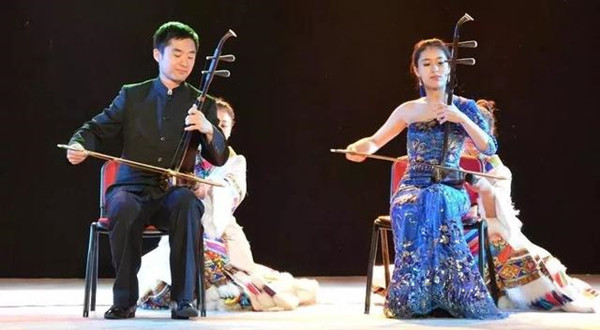How to distinguish erhu intonation according to acoustics (below)
If a player who has a very keen grasp of the intonation of the erhu, when he hears inaccurate tones in the performance of others or himself, most of them will have an indescribable discomfort and a feeling of something wrong. Often at this time, the performer will constantly adjust the position where he presses the sound until there is no abnormality.
This fully demonstrates the important role of hearing in controlling pitch and adjusting the position of the sound. For this reason, in the process of training students to control pitch, they should first train their acuity of hearing through instruments with fixed pitches such as piano, electronic organ, accordion, etc. The ability to hear the sound first ("inner hearing") in the mind before pressing the sound. Then, through different levels of scales, arpeggios and other exercises to adjust and stabilize the position of his (her) left hand pressing the notes and the accurate change of the scale.
For players with less acute hearing, the process of identifying and controlling intonation is also a relatively difficult training process. In this process, the performer must concentrate his attention (hearing) highly from beginning to end, and sometimes even repeatedly train the sense of the exact position of the notes on a note-by-note basis to cultivate and stabilize his tactile memory and distinguish between different pitches auditory memory. Only in this way can we train the ability to listen to the pitch well and master the accuracy of pressing the sound and changing the handle step by step.

The intonation training in erhu performance should be based on the twelve equal temperament, because only if you are familiar with and master the twelve equal temperament can you adapt to the frequent inversion, out-of-tune and complex scale structure in many pieces of music, and can express a wider range of music. content. Taking the twelve equal temperament as the basis does not mean that it excludes the combination of the fifth and pure temperament, which is inherent in the erhu performance. At the same time, in the practice of scales, arpeggios, etc. and the performance of music, not only should the performer realize the relative pitch of each note in different modes and different scale structures, but also teach him (she) to be proficient. To master the pitch tendency of the third and seventh grades according to the sound.
Only in this way will the clarity and stability of the melody be more prominent in the performance, and the hearing will be more satisfying. In some national modes, the neutral tones of the fourth and seventh, that is, high and low, are very distinctive and charming in performance, such as "bitter" and "happy" in the Shaanxi music style, and in the Cantonese music style. The "Yi Fan Xian" and so on. When playing music of these musical styles, you should press the tone according to the pitch requirements of neutral tones to highlight the unique style and charm of the music; The use of special pressing techniques such as "chanting" and "kneading" based on pressing and kneading can also highlight the rhythm characteristics of the music, making the music more unique and flavorful.
To sum up, the problem of intonation in erhu performance is very important and extremely complicated. It is the lifeblood of playing and an important premise. If you can't even press the erhu sound accurately, then no matter how skilled your playing skills are and how passionate the performance of the music is, this kind of performance will be meaningless.
 渝公网安备 50010702504639号
渝公网安备 50010702504639号